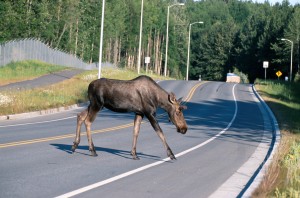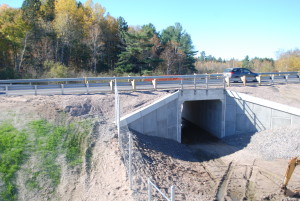Wildlife Corridors – Hwy. 11 South – Callander and Highway 69 South – Sudbury
Moving Our Moose – Under the Highway
by Back Roads Bill
We can’t give animals too many human characteristics, termed anthropomorphism; that is ‘The ‘Wonderful World of Disney’ syndrome. We can reduce our impacts on wildlife habitat.
Here is a stateside government, department of highways, definition. “Road kill is an animal or animals that have been struck and killed by motor vehicles. It occurs because wildlife and people driving vehicles are on the roads simultaneously, and cannot predict the behaviour of one another. Wildlife may wander onto roadways for various reasons and become road kill.”
The Iconic Moose
Driving along, there is not much worse than seeing a dead moose on the side of the road. There is now a newly designed, moose highway underpass to help mitigate this tragic eventually.
 Moose are majestic animals the largest of our ungulates and a Canadian icon. Its ubiquity in gift shops is difficult to miss.
Moose are majestic animals the largest of our ungulates and a Canadian icon. Its ubiquity in gift shops is difficult to miss.
A moose is distinguished by its conspicuous “dewlap” (the hair-covered flap of skin hanging from its lower jaw) and its larger, more flattened antlers when compared to a caribou. About 75 years after Canadians began making a national pastime out of mistaking the caribou on quarters for a moose, the Royal Canadian Mint is now selling a $5 special edition, silver coin. The moose is finally, like the beaver and the loon, depicted as the real deal — Alces alces, the king of all deer, the namesake of many places like Moose Jaw and products and services like Moosehead beer and Moose FM.
Those lucky enough to see a moose are amazed by their size: a mature bull stands as tall as a horse, weighs 600 kg (over 1,300 lbs.) and has palmate rather than dendritic (twig-like) antlers (called a “rack”) that span up to 150 cm (5 ft.).
Wildlife Underpass
The new wildlife underpass is located just south of Callander (Lake Nosbonsing/Wasi exit) on Highway 11 South and  just south of the truck inspection station (west side) 1.1 km south of Watson Rd. and 0.9 km north of Hills Rd./18th Concession Line (WGS 84 17 T 626708 5112504 or N46° 09’ 15.’6 W79° 21’ 32.6”. There is a moose crossing sign and you can safely pull off on to the shoulder to have a look-see.
just south of the truck inspection station (west side) 1.1 km south of Watson Rd. and 0.9 km north of Hills Rd./18th Concession Line (WGS 84 17 T 626708 5112504 or N46° 09’ 15.’6 W79° 21’ 32.6”. There is a moose crossing sign and you can safely pull off on to the shoulder to have a look-see.
From Ministry of Natural Resources information, Crown Game Preserves were established post WWI to help protect game from mounting hunting pressure. The Himsworth Crown Game Preserve was established by an Order-In-Council in 1949. It is 24 km² in area and in essence is a “protective island” surrounded by farmland. Logging is mostly permitted in game preserves and this is important to increasing food sources for browsing. There are currently 15 such preserves in the province, the Nipissing Crown Preserve is located south of Marten River on the east side of Highway 11 and the granddaddy is the Chapleau Crown Game Preserve (1925) covering more than 7,000 km², (check out the boundary lines on an Ontario road map), it is one of largest in the province, dwarfing most parks.
The Himsworth Crown Game Preserve is on the border of Wildlife Management Unit #48; there have been no recent moose surveys. Moose and deer coexist in 45 of 83 Ontario Wildlife Management Units surveyed for co-habitation. The persistence of moose in numerous areas with infected deer, and case studies of recent moose declines, (“moose sickness”) suggest that the effect of the deer parasite (Parelaphostrongylus tenuis) on moose populations is more subtle than once thought. So you will see both Bullwinkle and Bambi in this area, south of North Bay.
Deer (Odocoileus virginianus) are in abundance in this area. You can see the extensive wetland environment on both sides of the highway. Both deer and moose use this as a wildlife corridor to coincide with seasonal migrations to ![Deer_good_light[1] (2)](http://www.steerto.com/wp-content/uploads/2015/09/Deer_good_light1-2-300x169.jpg) protected areas. Regarding overall deer to moose populations, it is a 4:1 ratio, with a provincial deer population of approximately 400,000.
protected areas. Regarding overall deer to moose populations, it is a 4:1 ratio, with a provincial deer population of approximately 400,000.
These connecting corridors help separate or mitigate human activities; in this case the large volume of traffic and the multi-lane, Highway 11-South. Corridors increase the effective amount of habitat that is available for species and effectively reverse habitat fragmentation. This is especially important for migratory animals like deer and moose. Larger habitats support greater biodiversity, larger populations, and a wider range of food sources and shelter. A good example is the Loring Deer Yard. Thousands of white tailed deer spend the winter months, like a seasonal vacation, in this expansive area, south of Lake Nipissing.
As snow deepens, white-tailed deer will move into winter deer yards. These areas concentrate deer during the winter because they provide food and shelter from weather and predators. Deer will sometimes travel significant distances to these wintering yards.
Why and What
“The section of Highway 11 has a high rate of vehicle-wildlife collisions, primarily with deer. Approximately five wildlife collisions are reported in this area each year.” said Marlo Johnston, Head, Environmental Section, Ministry Transportation Ontario, NE Region. “It is expected that many more collisions are unreported. There are deer wintering areas on both sides of the highway that results in a travel corridor across the highway.”
She said, “Moose and bear are also abundant in the area and pose an additional collision risk. The Himsworth Crown Game Preserve on the east side of the highway presents ideal wildlife habitat and animals travel in and out of this area. The planned rehabilitation of Highway 11 presented an opportunity to install a wildlife culvert under the highway, as the highway was scheduled to be dug up and rebuilt “. The Highway 11 undercrossing cost approximately $900,000. In comparison, on the long term, consider all the personal and insurance costs, post-accident.
The wildlife culvert is two separate, four metre by four metre concrete box culverts, with a median opening to allow light through and avoid a tunnel effect. More than 2 km. of wildlife exclusion fencing funnels animals towards the crossing. An additional 3.5 km. of wildlife fencing is currently planned to be installed northerly towards the Wasi River Bridge where there is existing wildlife fencing. It is infrastructure way of persuading wildlife to move towards the underpass, crossing point; easier than the YouTube, 69 seconds long, “Cowboys herding cats” video.
This is the second wildlife culvert (underpass) in the province. The first wildlife underpass was installed on Highway 69 south of Sudbury in conjunction with the province’s first wildlife bridge (overpass), the first of its kind, east of the Rocky Mountains. You can’t miss it with the artistic wildlife icons, located just north of the Killarney turnoff.
Monitoring via motion activated, wildlife cameras is planned. Andrew Healy, MTO Environmental Planner said, “The cameras capture still shots at one second intervals. The use of similar cameras at the wildlife bridge and underpass has proven to be very effective and a cost efficient way to monitor wildlife use, and we are getting some really good data.”
Monitoring to date has shown that more than fifty animals have passed through the culvert in its first year, with usage increasing as wildlife adapt to the crossing. The structures work then!
Confusingly, in Europe, moose are known as Eurasian elk, and caribou are called reindeer. Moose cross the highway, not looking both ways; we have been conditioned to do so by Elmer the Safety Elephant. It is better to see moose alive and well; it is one of the derived benefits of driving the back roads.
